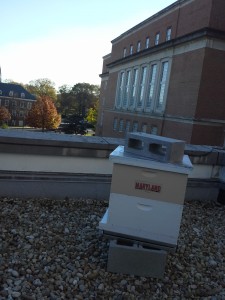As in the courageous worker ant from the fable, we beekeepers know that winter requires preparation starting in the summer. Bees spend their whole year building strong stores to allow a small fraction of their pairs to cluster around the queen all winter long and launch the colony as soon as possible in the following spring.
Winter preparation varies according to your region, but in the end, the core of the winter preparation is always the same: check your hives food stores and feed if necessary, reduce the size of the hive to the size of the cluster (you don’t want to give them too much space to guard and heat), always allow for a ventilation chimney (bees can handle cold, but they cannot handle humidity) and only overwinter strong colonies (combine or disperse the weak colonies who would not make it on their own).
By now (November, er even December), we think we have done all we could to give our hives the best chance to survive in this perilous period… Or, have we?
Even though you have fed, prepped, protected, sheltered, and shielded your colonies, it is actually still time to think of those extra last-minute winter preparations that can give your colonies an edge when facing this difficult stage of their annual cycle.
Are your hives ideally positioned? Choose a high ground spot to avoid humidity, maximize sun exposure and shelter your hive from direct wind. Avoid areas at risk of flooding or falling branches.

Secure the top covers by weighing them down.
Unless you are far north, you probably don’t need to wrap your colonies against the cold (and if you do, don’t forget to maintain a ventilation pathway through the hive).
Your hives should be elevated from the ground for a good air circulation. The hives can be tilted towards the front to help evacuate water condensation.
Leave the hive entrance open for good ventilation, but protect your hive against mice and other small rodents who could find the hive a perfect wintering place (read Heather’s blog on large hive pests). An easy and low cost solution is to bar your entrance with meshed wire, big enough for bees to pass, but too small for rodents.
You have fed your colonies and their stores are full. Now, make sure their stores are close to them. In a Langstroth hive, the honey frames should be on both sides of the cluster and above it. For the cluster in the winter every movement is an investment in energy. There is nothing more frustrating than to open your colony in the spring to find your bees head first in their wax cells, starved to death, with an intact food frame inches away from them…
Last year, the 2 leading causes of mortality over the winter as identified by backyard beekeepers in our annual Winter Loss and Management Survey were “colonies weak in the fall” and “starvation”.
Give your colonies the extra edge this winter!